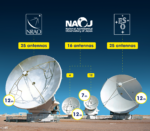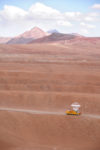Winning names for antennas after popular poll
ALMA is celebrating 10 years since it officially opened for astronomers. ALMA Early Science started on September 30, 2011 and its first image of the Antennae Galaxies, made using only twelve antennas working together, was released on October 3, 2011.
As part of this celebration, a month before the anniversary, names suggested by the public were collected to name the 66 ALMA antennas. There were two categories: Celestial objects and words in the Atacameño Kunza language, because the observatory is installed in indigenous territory. More than 200 concepts that met this criterion arrived, which a month later were presented to a popular consultation through the ALMA website and its social networks in which the public was asked to vote for the names they like the most.
Some 6,000 people voted and these and these are the concepts chosen and the assignment of names for each antenna:
Download PDF with descriptions and meanings
| Antenna | Region | Name | Meaning |
| CM01 | EA | Sol | Star that is in the center of the Solar System, with a mass composed mainly of hydrogen and helium. The energy radiated by the Sun is key to life on Earth |
| CM02 | EA | Amanogawa | Our host galaxy |
| CM03 | EA | Alpha Centauri | Closest star system to the Sun |
| CM04 | EA | Imai | Star of the Southern Cross |
| CM05 | EA | Heike | Star in the constellation of Orion |
| CM06 | EA | Murikabushi | The Pleiades or the Seven Sisters, according to the name given in the Yaeyama Islands of Japan |
| CM07 | EA | Haalar | Star |
| CM08 | EA | Bitchacma | Travel |
| CM09 | EA | Tuckur | Owl, who represents observation at night and wisdom |
| CM10 | EA | Atan | Night |
| CM11 | EA | Ckepi | Eye |
| CM12 | EA | Lickan | Town |
| DA41 | EU | Halley | Large, bright comet that orbits the Sun every 75 years on average |
| DA42 | EU | Europa | Sixth natural satellite of Jupiter |
| DA43 | EU | Acrux | Brightest star in the Southern Cross |
| DA44 | EU | Perseus | Northern constellation representing a mythological hero. In it is the famous variable Algol (β Persei), where the Perseid meteor shower is located |
| DA45 | EU | Andromeda | Closest galaxy to the Milky Way |
| DA46 | EU | Cruz del Sur | Constellation of the Southern Hemisphere composed of two crossed crossbars |
| DA47 | EU | Juno | One of the largest asteroids in the main asteroid belt of our Solar System. Observed by ALMA |
| DA48 | EU | Hydra | The largest constellation of the 88 that exist |
| DA49 | EU | Antares | The brightest star in the constellation of Scorpio |
| DA50 | EU | Cassiopeia | Constellation easily recognizable by its five bright stars that form a familiar "M" or "W" pattern pointing North |
| DA51 | EU | Rigel | Blue supergiant star in the constellation Orion; star system of at least four stars that appear as a single point of blue-white light to the naked eye |
| DA52 | EU | Aldebaran | Brightest star in the constellation of Taurus |
| DA53 | EU | Io | The Galilean satellite closest to Jupiter |
| DA54 | EU | Selti | Blue |
| DA55 | EU | Puri | Water |
| DA56 | EU | Semann | Together |
| DA57 | EU | Ckeltchar | Truth |
| DA58 | EU | Lalackama | Aurora |
| DA59 | EU | Lalchtchir | Lights |
| DA60 | EU | Laipintur | To look |
| DA61 | EU | Haabu | Breath (ALMA can capture the breath of the stars) |
| DA62 | EU | Ckoi | Voice (In the sense of hearing the voice from space) |
| DA63 | EU | Muckar | Dead, because life and death of planets and stars coexist |
| DA64 | EU | Kala | Yellow, the color of the Sun here on Earth |
| DA65 | EU | Ckoitchi | Rainbow |
| DV01 | NA | Nubes de Magallanes | Two galaxies visible from the Southern Hemisphere |
| DV02 | NA | Sirius | The brightest star in the entire night sky as seen from earth, located in the Southern Constellation Canis Maior |
| DV03 | NA | Orion | It is a constellation visible throughout the world and one of the most recognizable constellations in the night sky |
| DV04 | NA | Pluto | ALMA measured Pluto's location and orbit around the Sun with great precision in order to help NASA's New Horizons spacecraft reach its goal before approaching that dwarf planet in 2015 |
| DV05 | NA | Luna | The only natural satellite of the Earth and the fifth largest in the Solar System |
| DV06 | NA | Mimosa | It is the second brightest star in the constellation of the Southern Cross |
| DV07 | NA | Titan | The largest of Saturn's satellites and the second largest in the Solar System after Ganymede. Also, the only known satellite to have a significant atmosphere, and the only object, apart from Earth, in which clear evidence of stable liquid bodies on the surface has been found |
| DV08 | NA | Vega | Main star of the constellation of Lyra, widely studied and classified as the most important star after the Sun |
| DV09 | NA | Proxima Centauri | The nearest-known star to the Sun |
| DV10 | NA | Venus | Second planet in the Solar System in order of proximity to the Sun. It lacks natural satellites and receives its name in honor of the Roman goddess of love |
| DV11 | NA | Lyra | Constellation easily identifiable by its star Vega |
| DV12 | NA | Jupiter | It is the largest (gaseous) planet in the Solar System and the fifth in order of distance from the Sun |
| DV13 | NA | Ttulti | Night |
| DV14 | NA | Mitchi | Feline (cougar-cat) |
| DV15 | NA | Ckaickai | Ear, because the antennas listen to the Universe |
| DV16 | NA | Hicka | Signal |
| DV17 | NA | Ckontor | Condor, national symbol of the Andean countries |
| DV18 | NA | Pattahoyri | Mother Earth |
| DV19 | NA | Ckapin | Sun |
| DV20 | NA | Ack'cka'ya | I am, is the essence of everything that exists, and what is yet to be discovered, but still exists |
| DV21 | NA | Sairi | Rain |
| DV22 | NA | Taipu | Tomorrow |
| DV23 | NA | Tturi | House |
| DV24 | NA | Hai'may'tier | To learn, to know or to understand |
| DV25 | NA | Tchitack | Heart (ALMA looks into the heart of the Universe) |
| PM01 | EA | Ckamur | Moon |
| PM02 | EA | Ckausama | Life |
| PM03 | EA | Orochi | Very bright and rare galaxy since it is forming new stars at a rate of more than 1000 stars per year |
| PM04 | EA | Karasukiboshi | It is the alignment of the three bright stars Alnitak, Alnilam and Mintaka, together with nearby three fainter objects including the Orion Nebula |
#ALMAnames Poll Winners

ALMA Antennas
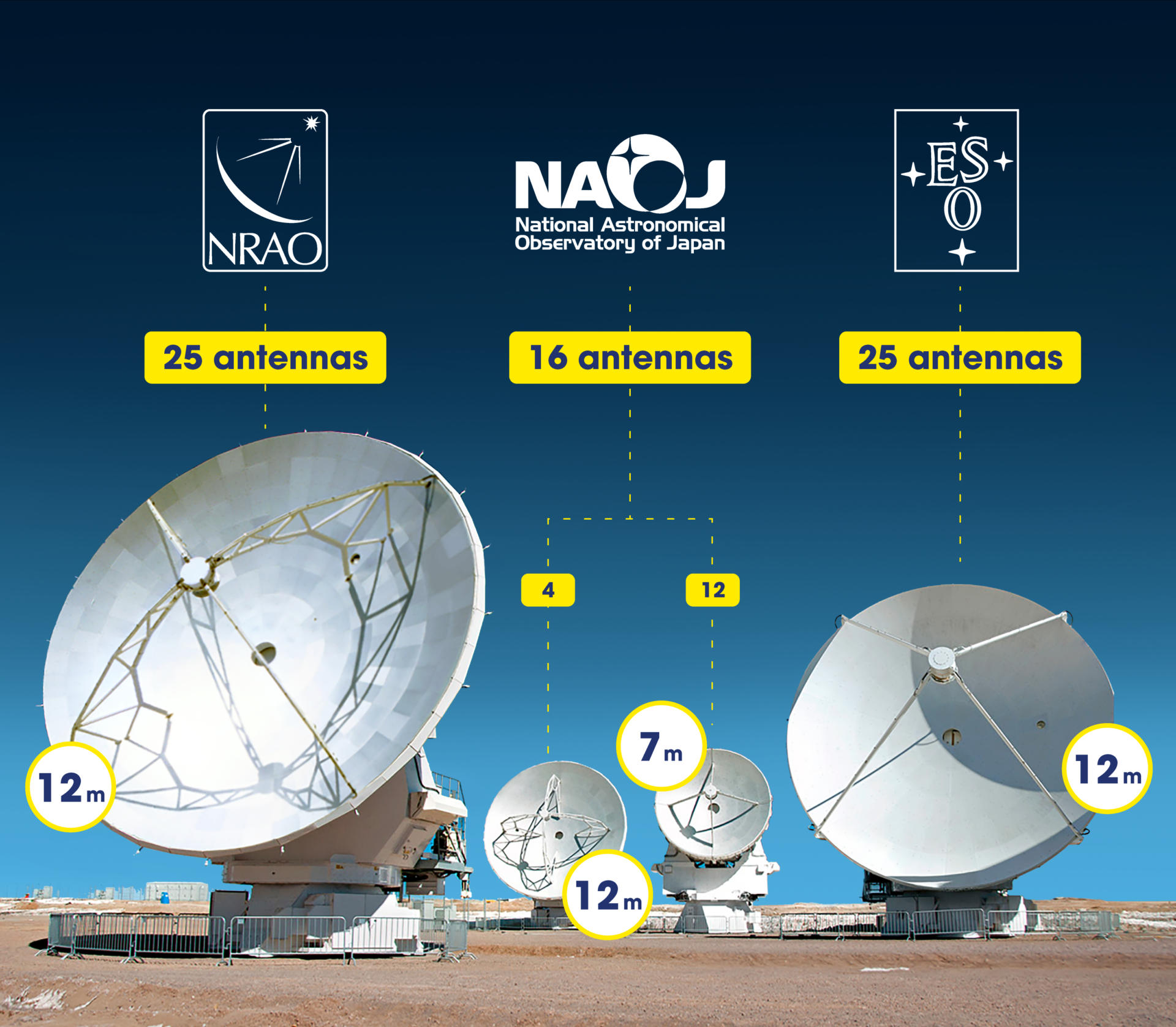
If you take a close look at photos of ALMA, you will see that there are three different types of antennas. 25 antennas were built by the North American partners. European partners built 25 antennas. And 16 antennas (four big and twelve smaller ones) were built by the East Asian partners. So everyone helped to build ALMA.
In total, ALMA has 66 antennas: fifty-four 12-meter diameter antennas and twelve 7-meter diameter antennas. The radio telescope combines signals from each, working as an interferometer, in other words, a single giant telescope equal in size to the total array.
With perfect parabolic shapes and a precision equivalent to within a fraction of the thickness of a human hair, this is one of the most precise antennas in the world.
Unlike a telescope that is built in place and remains there, these antennas are solid enough to be moved between different pads without damaging their high-precision mechanisms. They are moved with transporter trucks that have been designed especially for these antennas and are able to reposition them to adapt to the required observation needs.
They do not need a dome or cupola to protect them. Although their reflectors are exposed to extreme conditions at an altitude of 5,000 meters above sea level in the Chajnantor Plateau, facing gusty winds and temperatures that vary from 20 to -20 degrees Celsius, and even snow, the antennas are designed to withstand these conditions.
History
In 2009, the first completed antenna was transported from the ALMA camp or Operations Support Facility (OSF) to the Chajnantor Plateau or ALMA Operations Site (AOS), at 5,000 meters above sea level.
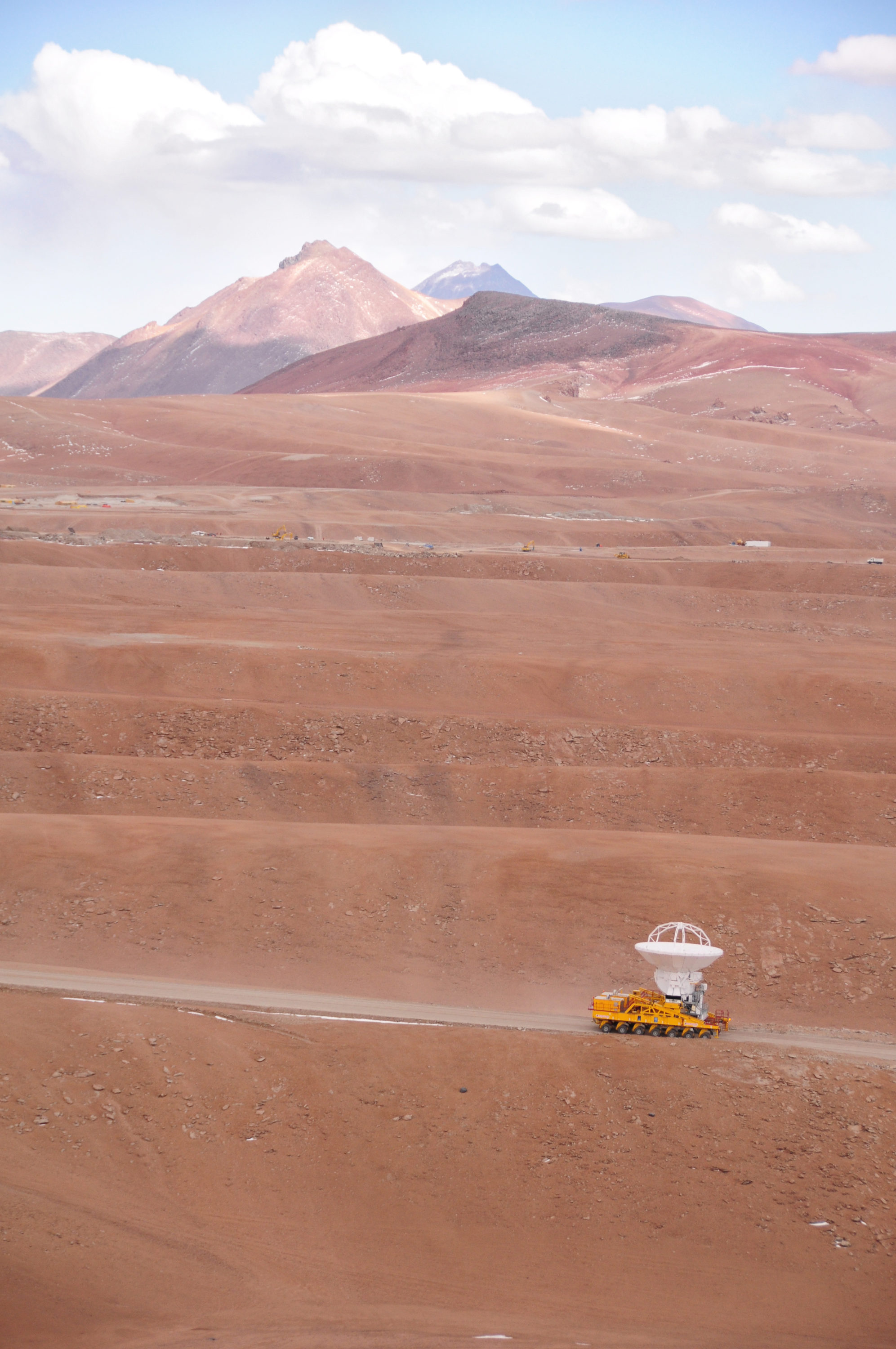
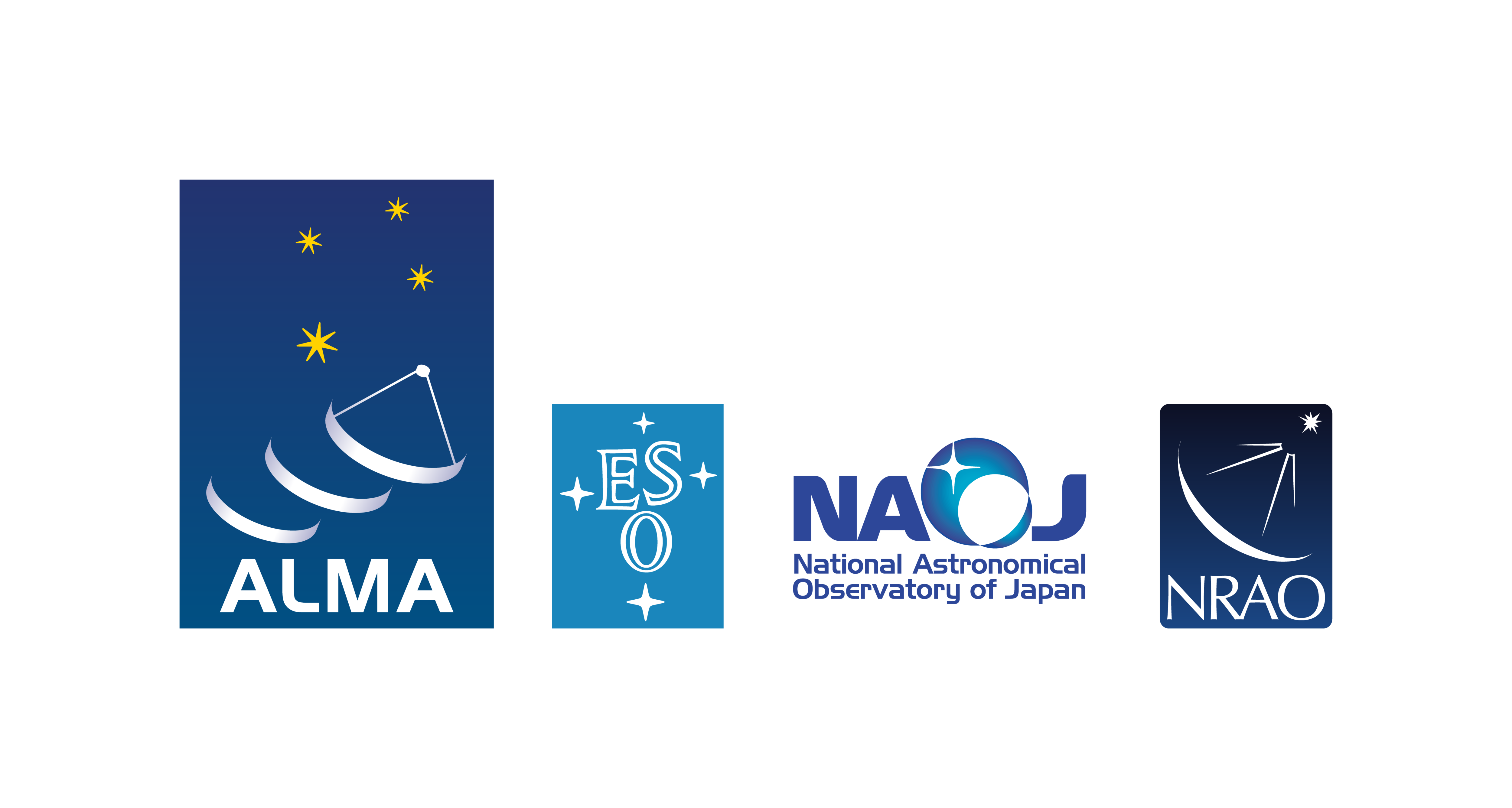
ALMA, A WORLDWIDE COLLABORATION
The Atacama Large Millimeter/submillimeter Array (ALMA) -the largest astronomical project in existence- is a single telescope of revolutionary design, composed of 66 high precision antennas located on the Chajnantor Plateau, 5000 meters altitude in northern Chile. ALMA is an international partnership of the European Southern Observatory (ESO), the U.S. National Science Foundation (NSF) and the National Institutes of Natural Sciences (NINS) of Japan, together with NRC (Canada), MOST and ASIAA (Taiwan), and KASI (Republic of Korea), in cooperation with the Republic of Chile.
Contacts
-
Masaaki Hiramatsu
Education and Public Outreach Officer, NAOJ Chile -
Bárbara Ferreira
ESO Media Manager -
Amy C. Oliver
Public Information & News Manager

